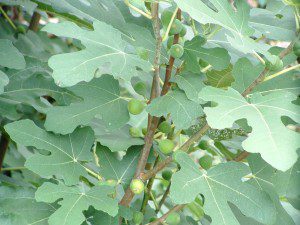You can let go of the concerns over growing fruit trees in the backyard garden because figs have a way of erasing all the worries and reservations, especially when these easy to care for trees are raised in containers.
For the record, most fruit trees can be demanding in their space requirements, and less than welcoming about sharing territory with other plants. But fig trees will happily grow within rather confined quarters, and container grown figs are easy to train and maintain into a compact, standard tree form.
It’s Not Mission Impossible to Raise Fruit in the Home Garden
 Where many tree fruits are considered almost impossible to cultivate without yielding to complex spray schedules to combat insects and diseases, fig trees are comparatively pest free and a cinch even for no-spray organic gardeners. And fig trees don’t leave you clinging to promises of the future; they’ll often begin bearing delicious fruit within a year or two!
Where many tree fruits are considered almost impossible to cultivate without yielding to complex spray schedules to combat insects and diseases, fig trees are comparatively pest free and a cinch even for no-spray organic gardeners. And fig trees don’t leave you clinging to promises of the future; they’ll often begin bearing delicious fruit within a year or two!
The backyard orchard’s arsenal of ladders, pruning saws, grafting tools, pesticides, and fungicides are all obsolete and unnecessary for the fig grower. In fact, if you stick with the “Common” fig varieties you don’t even have to rely upon your friendly bees and other pollinators to do their job as many fig trees are completely self-fertile.
Relax and Enjoy a Hassle Free Harvest of Fresh Figs
When harvest time arrives there’s no guessing to determine when the fruit is ripe, and no stretching, bending, or straining is required to harvest the fruits from container grown fig trees. Just reach out and touch the figs that are delivered at about eye level with your feet never leaving the ground.
Sure there are other fruit trees that you can plant in containers but they just don’t take to it as naturally as a fig will. With fig trees there are no dwarfing rootstocks required, no special varieties that have been bred to grow in an unnatural manner, and no foreign insect pests to struggle against.
Special Care for Container Grown Fig Trees
I know, nothing’s perfect and there are a few obstacles or challenges involved with cultivating fig trees. First of all they are more of a sub-tropical and cannot tolerate cold weather with the same ease as an apple tree. However with container grown fig trees the way to get around that problem is simple; just move the potted tree into an unheated garage or building for the winter.
Fig trees aren’t generally heavy feeders and don’t require a lot of water, but container grown plants will need to be monitored and attended to on a more regular basis than trees that are growing in the ground. You will occasionally need to repot or root prune figs that are container raised to keep them healthy and productive.
Other Considerations for the Fig Grower
There are a couple of pests and diseases such as mosaic virus, leaf rust, and root knot nematodes that can afflict fig trees but they are not usually a major problem in the home garden. While figs are not as popular with birds and four legged bandits, you may need to provide some protection against pilfering as the fruit matures and begins to ripen.
I’m expanding my collection of fig trees this spring and they will all be container bound, as that will work best and allow for the most flexibility in my backyard. The trees will spend the summer lounging around the patio and I’ll just move them into the garage before winter arrives.
If you’re ready to broaden your gardening in the direction of offering more backyard fruits; fig trees will make a great addition to the home garden. The next post will offer a few specific tips for growing figs in containers.



 Address:
Address: EMAIL:
EMAIL: Telephone:
Telephone: